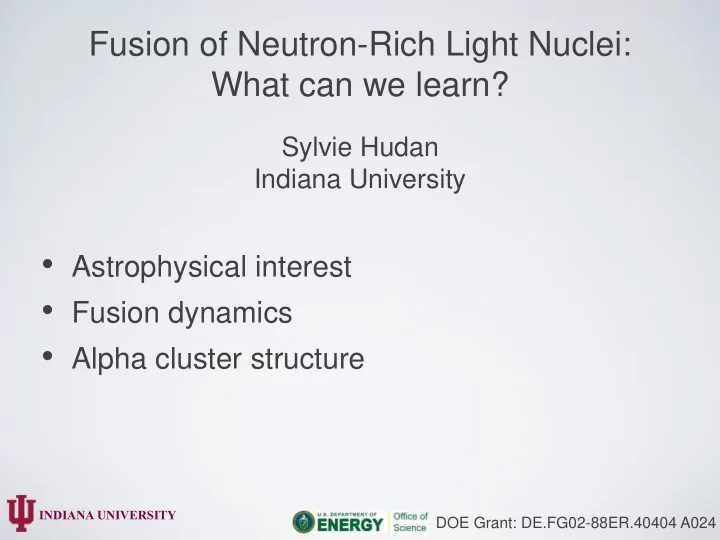

Fusion of Neutron-Rich Light Nuclei: What can we learn? Sylvie Hudan Indiana University • Astrophysical interest • Fusion dynamics • Alpha cluster structure INDIANA UNIVERSITY DOE Grant: DE.FG02-88ER.40404 A024
Neutron Star Crust • Accreting neutron stars presents a unique environment for nuclear reactions • Identified as the origin of energetic X-ray superbursts • X-ray superburst: ~10 42 ergs • Annual solar output: ~10 41 ergs • X-ray superbursts thought to be fueled by 12 C + 12 C fusion in the outer crust • However, the temperature of the outer crust is too low (~3x10 6 K) for 12 C fusion • Neutron- rich light nuclei fusion as potential “heat source” • If valence neutrons are loosely coupled to the core, then polarization can result and fusion enhancement will occur Cumming et al. , Astrophys. J. Lett. 559 , L127 (2001) Strohmayer et al. , Astrophys. J. 566 , 1045 (2002) Horowitz et al. , Phys. Rev. C 77 , 045807 (2008) Haensel et al. , Neutron Stars 1, 2007
DC-TDHF and Fusion Dynamics 16 O + 16 O Ecm (MeV) 16 O + 24 O “For the n -rich system the barrier peak is at a larger R 10 value since the nuclei come into contact sooner due to 8.5 the extended n skin of the 24 O nucleus.” 9.4 6 6.5 4 3.7 3 • Neck formation, surface vibrations and density fluctuations observed • Enhancement of the fusion cross-section at and below the barrier related to neutron transfer for n- rich systems and dynamical effects DC-TDHF calculations: A.S Umar et al., PRC 85 , 055801 (2012)
Alpha Cluster Structure • Alpha cluster structure has been predicted and observed for light nuclei • Observation of rotational bands Horiuchi and Ikeda, Prog. of Th. Phys. 40 , 277 (1968) Chernykh et al. , PRL 98 , 032501 (2007) von Oertzen et al. , EPJA 43 , 17 (2010) von Oertzen, Int. J. of Mod. Phys. E 20 , 765 (2011)
Fusion Studies with Low Intensity Beams ~ 130 cm ~ 16 cm 18 O BEAM DS MCP TGT MCP Detector Detector US MCP T2 LCP Det. Detector T3 Array • MCP detectors: start for TOF, beam counting, beam cleaning • ExB design to minimize scattering • Fusion residues detected in segmented Si detectors: stop for TOF, energy and angle • Sub-nanosecond time resolution, small dead layer, lowest segmentation as possible • Decay products (p/alpha) detected in Si detectors and CsI(Tl) array • Maximum beam intensity: ~5x10 5 pps T.K. Steinbach et al. , NIMA 743 , 5 (2014)
Extracting Fusion Residues • Evaporation residues identified by energy and time-of-flight • Elastic scattering • Beam Scatter (largely reduced with ExB MCP detector) • Evaporation residue island • Emitted particles (p, ) • Evaporation residues • Count: fusion cross-section • Energy, Angle, A (via TOF)
Fusion Cross-Section • Cross-section measured down to 820 µ b • At higher E c.m. : σ expt /σ DC-TDHF ≈ 0.75 • Breakup reactions • For sub-barrier energy: slower fall off of the experimental cross-section as compared to TDHF • Larger tunneling probability for the experiment: Narrower barrier? • Lack of pairing evolving in time in TDHF?
Alpha Cluster Structure • Statistical codes under- estimate experimental α cross-section • Relative enhancement relative is energy dependent • Similarity of the α cross -section for different systems as a function of E c.m. • Pre- existing α cluster structure in the entrance channel • Collision dynamics
19,18 O + 12 C @ Florida State U. • Beam characteristics: 18 O(d,p) 19 O • Gas Cell Energy (MeV) 18 O @ ~75 MeV • • D 2 target: P ~ 350 Torr, T ~ 77K • Beam on target: ~1-2x10 4 pps • Beam purity: 25 - 50 % 19 O TGTMCP - USMCP TOF (ns) • Active Degrading Ion Chamber (CF 4 ): energy change and PID event by event • Simultaneous measurement of RIB and know reference beam
19 O+ 12 C • Measured fusion cross-section for 19 O + 12 C from E c.m. ~ 7.5 to 18 MeV • Hint of a small enhancement • Cross-reference system for systematics errors assessment • Data also taken for 17 F and 16 O
Conclusion and Future At ReA3 • Ability to measure fusion of with low intensity beams • Cross-section to the 800 µb level • Decay channels, in particular alpha channels • Near term at ReA3: 39,47 K + 28 Si (15214) • Addition of a third Si detector at small angles to measure ~75% of residues • Future needs • Systematic fusion measurement with neutron- rich “light” nuclei • At and below the barrier to maximize barrier change with neutron number • Beam intensity: 10 4 – few 10 5 pps
Acknowledgments • Indiana University Nuclear Chemistry group J. Huston, J. Schmidt , T.K. Steinbach, J. Vadas, B.B. Wiggins V. Singh, S. Hudan, R.T. deSouza • Florida State University John D. Fox Accelerator Laboratory S.A. Kuvin, L.T. Baby, V. Tripathi, I. Wiedenhöver • The DOE for the support, Grant: DE.FG02-88ER.40404 A024 INDIANA UNIVERSITY
Recommend
More recommend